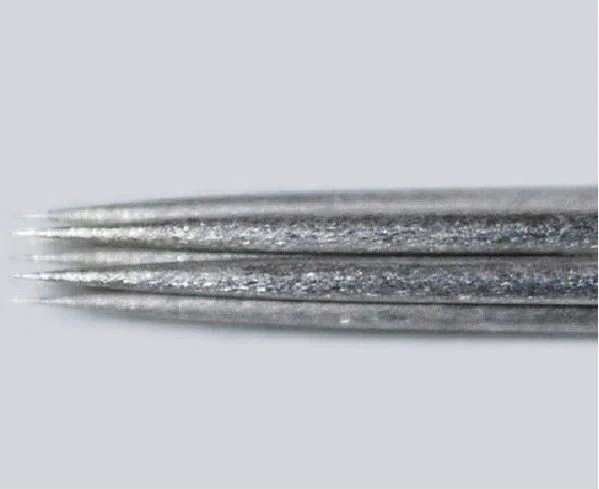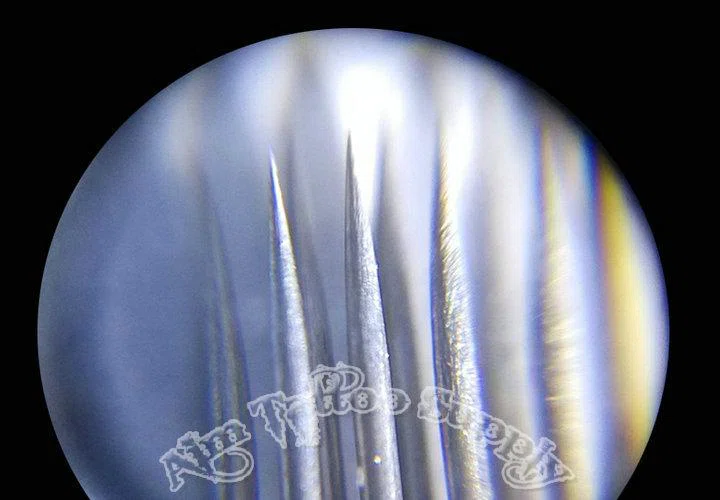What is the 'taper' in a tattoo needle?
What influences the taper when tattooing
04 January 2024
The types of needles for tattooing and the techniques are many and increasingly varied.
As we told you in the article Tattoo needle guide, each job corresponds to a different tool.
Any artist needs to know how these materials work and how they are made.
This time, we will discuss the so-called 'taper' found in all tattoo needles and directly influences the moment of injecting the ink into the skin.
Let's go for it.
What is the taper?
The taper is the length at the end of the needle.

That is to say, from the part where the tip begins to be sharpened to its end. Depending on its length will determine the type of taper that this needle has and its use.
Taper measurements can be defined in three:
- Medium taper (MT), which has a total length of 2.5 millimetres;
- Long taper (LT) with a 3.5 mm termination; and
- Extra long taper (XLT), which has 5.5 mm.
However, some consider adding an even shorter measure, the so-called 'short tape', which has a length of 1.5 millimetres but is practically not used since it is too sharp and causes much damage to the skin.
Each type of needle, whether Round Shader, Magnum, Round Liner or any other, can have a different taper diameter. How to know? Well, simple.
Manufacturers indicate the taper size on the needle wrapper with the corresponding acronym MT, LT or XLT.
According to its configuration, the terminology of the needles would be as follows:
If we had a 5 Round Liner needle, with a medium taper, on the packaging, it would be marked as RL 05 - MT.
Each manufacturer can indicate it in this order or another, but always remember that when you see the letters M, L or XL, they refer to the specific diameter of the taper.
What taper size to choose?
To calculate the taper size that works best for you, you must consider something crucial.
The longer the taper, the sharper the tip and the more flexible, the more flimsy.
This happens because the tips become increasingly sharper and, therefore, lose consistency and become finer.
For this reason, for example, to do shading or lines that do not require as much pigmentation, you can opt for LT or XLT taper sizes.
But remember that each manufacturer designs the tapers differently, either in the termination type or its texture.
In principle, you must prioritise the type of needle you want to use, be it RS, RL, M etc. From there, you will see the taper diameter that suits you best.
To find the best taper, we recommend you practice a lot and try needles from different manufacturers to choose one with better criteria.
Textures in the taper
In addition to the diameter, almost all tapers have a texture that sets them apart.
The texture is practically invisible to the human eye and consists of small holes carved in the taper, intended to deposit a certain amount of ink.

Depending on the designs and the cavity of each hole, these will be able to accumulate more or less ink, which allows you to regulate the amount you want and need to inject on each occasion.
Thus, when you need to make powerful strokes with intense pigmentation, you can opt for a needle with a texture capable of holding the ink for longer.
But here, the composition of the inks also comes into play.
Why do we say this?
Because, for example, according to the manufacturers, on the market, you can find thicker inks than others, and this directly affects the effect they produce on the skin and the design.
For this, you must study the composition of the inks you use, and from this, you can choose with better criteria the type of texture you should use each time.
On the other hand, not all manufacturers include texture on their needles.
In general, they usually indicate it on the packaging, but occasionally this is not the case. One way to detect it with the naked eye is to look at the tip of the needle on the light, and if it does not shine, it remains relatively opaque, meaning it is textured.
On the other hand, if it is gleaming, the needle has no texture and it’s called polished.
So, which taper is better?
As we always say, there are no better or worse elements. They always depend on the type of work you want.
You should not ask yourself what is better, but rather what you want it for and what you want to do.
For that, the best would be you try different brands and designs until you have more mastery of the needles with broader criteria.
Remember that a shorter taper will help you make strong strokes; conversely, a long taper will help you make softer strokes. In addition, to this is added the measurement of the needles.
So, there is no single rule. It all depends on your preferences and the design needs you want to make.
That's why, first, you need to be deeply informed and learn as much as you can from experienced tattoo artists, since this profession is mostly based on empirical knowledge, that is, trial and error.
Something that we cover completely in our intensive courses of professional tattooing; where you not only learn all the theory and methodology necessary to tattoo, but you put it to the test with practical exercises that help you go from synthetic skin to human with the least possible risk.